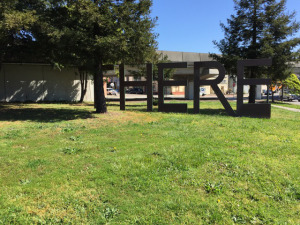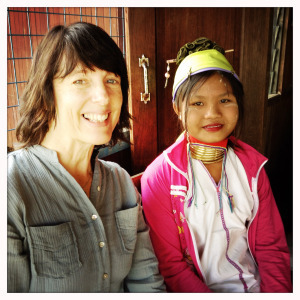Teresa Bruce's Blog, page 31
March 24, 2015
Bless Berkeley’s heart, and I mean that with syrupy Southern sweetness
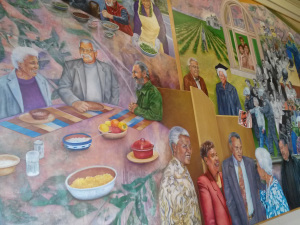 Inside Berkeley’s city hall, and yes, that’s Fidel
Inside Berkeley’s city hall, and yes, that’s Fidel Outside South Carolina’s capitol
Outside South Carolina’s capitolAs a travel-loving, non-religious feminist living and writing in the state of South Carolina, I confess to often feeling like an expat in my own country. I am inspired by the beauty of the place and the eccentricity and humor of its people but find it tough to reconcile things like a confederate flag flying on state capitol grounds. Or that our senators vote against women’s rights while declaring family values. Beaufort, my adopted hometown, actually lobbied to let the world’s loudest fighter jets train, day-and-night, over residential neighborhoods and mostly black public schools. When a famous modern dance company staged a performance for the Byrne Miller Dance Theatre, a city councilman in Beaufort threatened to cut funding over scant costumes.
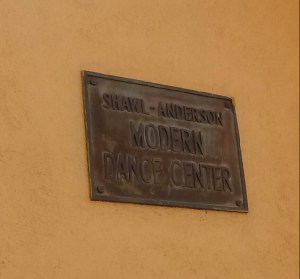 So when I flew to Berkeley, California to shoot a video last week I should have felt liberated, among my tribe. Modern dance is so mainstream that studios have weathered brass nameplates. Instead of ear-splitting F35s and military bases, Berkeley is famous for anti-Vietnam war protests on campus. It’s so liberal here that dispensers of medical marijuana are required to set aside a percentage of pot to donate to poor people. It must be true; they even wrote about it The New York Times.
So when I flew to Berkeley, California to shoot a video last week I should have felt liberated, among my tribe. Modern dance is so mainstream that studios have weathered brass nameplates. Instead of ear-splitting F35s and military bases, Berkeley is famous for anti-Vietnam war protests on campus. It’s so liberal here that dispensers of medical marijuana are required to set aside a percentage of pot to donate to poor people. It must be true; they even wrote about it The New York Times.
On the Oakland side of the Berkeley city border stands a metal “There” sculpture immortalizing the famous Gertrude Stein memoir declaring “there is no there there.” Trees shading the “Here” sculpture that welcomes drivers to much-swankier Berkeley make it look like “HER” A progressive, pacifist woman like me should love it here.
But what I discovered was that when too many lucky, like-minded people live in the same place we can be as bombastic as any redneck right-wingers. Take the problem of obesity, for example. In Berkeley, more than 70% of voters approved a tax designed to discourage consumption of soda – one penny per ounce – but only on distributors and only on soda. They didn’t impose sugar taxes on fancy, expensive coconut waters or quasi-holistic kombucha bottled teas. Whipped cream-crowned liquid desserts sold in gourmet coffee shops are exempt too. So are donuts, candy and processed foods, like ketchup, with loads of hidden sugar. They wanted to be the only city in the country with a sugar tax on soda in order to make a point. Apparently uber-educated, ultra-liberal Berkeley has figured what’s best for everyone.
 tax added to a can of soda in Berkeley
tax added to a can of soda in BerkeleyA part of me wanted to cheer the the city on. I’m trying to cut back on sugar and personally don’t drink sodas. But the sponsors of Berkeley’s law didn’t talk to the low-income workers, living in food deserts, who buy half-liters of generic soda at corner liquor/snack stores. These are the people who wait tables and clean rooms in Berkeley but can’t afford to live or vote there. Consumers who know the exact coin count of their favorite soda brand can’t just switch to the newest, healthiest fad drink. And the owners of mom-and-pop stores are watching their customers walk across the street to not-there Oakland, a city that hasn’t singled out soda as the new “we know better.”
I’m writing about this because there’s a little Berkeley bully in all us liberals. I realize sugar taxes on soda hardly compare with the big “values” issues that make me an expat in my own corner of the country. But I was wrong to think only gun-toting, gay-bashing conservative states have the corner on moral tyranny.


March 20, 2015
The Choreography of Air Shows
 rhythmic gymnastics choreography
rhythmic gymnastics choreography air show choreography
air show choreographyAs readers of “The Other Mother: a rememoir” know, I spent the best years of my youth twirling ribbons, juggling clubs, rolling hoops and tossing balls as an almost-Olympic rhythmic gymnast. I designed most of my own routines but occasionally got to work with the national team choreographers. But I never imagined I’d be writing about a different kind of choreography altogether — the demonstration routine performed by the world famous GEICO Skytypers.
Instead of gymnasts, I’m writing about pilots — captains of major airlines with thousands of hours flying military planes as well — who spend their weekends flying vintage World War II trainer planes called SNJ’s. If you’ve watched any Hollywood WWII movie, you’ve seen these planes and heard these Pratt Whitney engines. And if you’ve ever been to an air show, you’ve seen aerial choreography not altogether unlike that on the Olympic mat.
Instead of six gymnasts using their bodies to perform ridiculous acts of flexibility and grace, the Skytypers use six 75-year old planes.
A pilot named Steve Salmirs spent the last six months dreaming up a new opening manuever for the Skytypers’ 18-minute precision flying demonstration — and it debuts this weekend at the Melbourne Beach Air and Space Show in Florida. You can read all about it on my officialblog for the team or follow them on Twitter or Facebook. But here’s a sneak peek of the front part of the new maneuver.
I can’t show you the rest because it’d ruin the surprise for the quarter-of-a-million spectators turning out this weekend for the show.
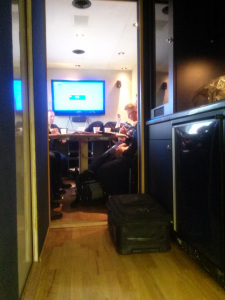 Watching the team work on the routine during Spring Training this week in Florida, and in full dress rehearsal today for their season opener was a flashback to putting the finishing touches on a new rhythmic routine. A gymnast goes over the moves in her head, talking each element through with the coach in an almost trance-like method of memorization. The pilots do that in their mobile briefing room — an 18-wheeler outfitted with a giant video screen just for analyzing their performances. Then, just like “marking” new choreography by walking through the positions on the mat, these pilots walk through the whole routine on the tarmac before they ever fire up the planes.
Watching the team work on the routine during Spring Training this week in Florida, and in full dress rehearsal today for their season opener was a flashback to putting the finishing touches on a new rhythmic routine. A gymnast goes over the moves in her head, talking each element through with the coach in an almost trance-like method of memorization. The pilots do that in their mobile briefing room — an 18-wheeler outfitted with a giant video screen just for analyzing their performances. Then, just like “marking” new choreography by walking through the positions on the mat, these pilots walk through the whole routine on the tarmac before they ever fire up the planes.
Of course the stakes are incredibly higher. The worst that could happen if a group routine in rhythmic gymnastics goes wrong is a low score. In an air show lives are at stake. Which is why these pilots are as dedicated to perfection as any Olympic athlete.
And tomorrow, if that Russian judge dares to score the GEICO Skytypers less than a 10, they’ll have to answer to me.



March 12, 2015
The Florida foreigners see
 I wore the right jacket at least
I wore the right jacket at leastAs a travel blogger and author regularly enchanted and transformed by other countries, I’ve often wondered what aspect of traveling in my own country appeals to foreigners. It’s not as obvious as you might think. We’ve got awe-inspiring natural splendors and incredible geographic diversity – but nothing a native Argentinean couldn’t find in Patagonia, or a European in the Alps or an African in the Sahara. As for history, even our 300-year old landmarks would underwhelm tourists from places more long in the tooth.
I’m convinced that the stories travelers take back from the United States have more to do with how proud (and free) we are to fly our freak flags. Take last weekend in Florida, for example. I make the 6 hour drive down I-95 to Orlando as infrequently as possible. Too many wrecks. Way too many weirdos. We were driving over a bridge in Jacksonville a few years ago when Gary noticed a white panel van, bungee-corded together, driving suspiciously slow in the left lane. Something or someone was thumping the walls of the van from the inside. What’s creepy about this story is that we both shrugged and said “Freaky Florida” – in unison – before snapping to our senses and calling in the license plate to 911.
Last weekend changed my view of Florida. My brother-in-law turned fifty and we got to Deland with a few hours to kill before his surprise party. As luck would have it, the main street of this charmingly “historic” city was reserved for Harley Davidsons. It was Deland’s “Bike Day” – the kickoff of the world-famous Bike Week in nearby Daytona. I have never seen so much muscle, machismo and flat out sexy machinery in my life. The riders today are a far cry from the Hell’s Angels that made the bike an American icon. I saw as many cappuccinos as beers clutched in the fists of baby boom bikers walking up and down the streets. The mood was more family reunion or corner bar happy hour than motor-revving tough. One couple even got hitched. The biggest surprise to me was the creativity – there were keg-powered hogs, Harleys crossed with old-time horse buggies, side car grilling stations and paint jobs that would make Michelangelo swoon. This was American ingenuity and can-do writ large. And loud.
No wonder tourists flock to America, and states like Florida. Especially when Sky Dive Deland is just up the highway. It was packed with foreign tourists spending their money with huge, skin-flappy grins on their faces. That’s what happens to even lithe, fit people’s faces when they fall through 14,000 feet of sunny Florida sky.
I’m not sure who invented skydiving, or where, but it could not be more American in spirit. All it takes to get started is renting a parachute, watching a short video and a willingness to have a complete stranger ride on your back controlling your tandem descent. Money, media and instant intimacy – followed by high-fives and beer at the “Perfect Spot” bar adjacent to the landing field.
Most of the foreigners were in Deland for an international team skydiving competition, pitching tents in the field to save money for jumps and beer. This is the “America” they’ll talk about for years. American ambassadors don’t serve in far-off embassies. They spit polish their beautiful bikes. Jump out of perfectly good planes. Smile for any camera. Raise a glass, or a can, to any celebration. America’s biggest tourist attraction is our freedom to be and do whatever we can afford, no matter how freaky.


March 5, 2015
U.S.-Cuba negotiations through the lens of photography
So the second official round of talks to reestablish diplomatic relations between Cuba and the United States wrapped up last week and the tricky bits are beginning to overshadow the initial excitement. Not surprisingly a huge hang-up is money, because banking in Cuba is hamstrung by its designation as a sponsor of terrorism. You can read all the details in this Reuters piece or this New York Times article, or just talk to any Cuban artist or American collector.
Even though it’s been legal to import Cuban art and photography ever since Sandra Levinson and her Center for Cuban Studies won a pioneering lawsuit against the U.S. Treasury Department in 1991, actually paying for pieces is still a hassle.
One amazing contemporary artist we met was willing to take a 10% down payment in Cuban currency, let us walk away with a $10,000 painting and work out the details later through the honor system. We don’t routinely walk around with $1,000 in our pockets and you can’t walk up to an ATM for extra cash in Havana so we couldn’t even consider the generous, trusting offer of an artist.
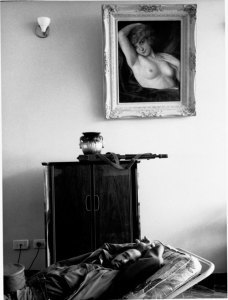 A Corrales print acquired by the Rebekah Jacob Gallery in the 90s
A Corrales print acquired by the Rebekah Jacob Gallery in the 90sTurns out we were smart to sweat the small stuff. Art historian Rebekah Jacob, who sells vintage Cuban revolutionary photography prints from her gallery in Charleston, once had an entire shipment of purchased work impounded by U.S. customs and the legal bill to sort it all out would have been costlier than the photographs themselves.
 Fototeca De Cuba in la Plaza Vieja
Fototeca De Cuba in la Plaza ViejaRobin Blackman is another gallerist who fell in love with Cuban photography when she first visited the famous Fototeca De Cuba center in the 80s. She and her photographer husband were so impressed with the work of new generation of Cuban photographers that they opened an LA branch of Fototeca. She says it became the first independent gallery in the US to develop a relationship with the Cuban government and bring an exhibit of emerging photographers to LA. Eventually the Fototeka LA gallery closed but she still has a few vintage prints. Here’s the crazy part. She recently sold a few but can’t pay the photographer because, decades later, the embargo means he can’t accept US dollars and he doesn’t have internet access to keep in touch on a regular basis.
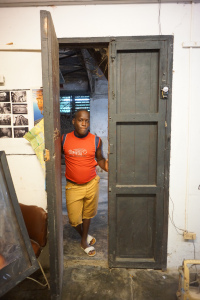 garygeboyphotography.com
garygeboyphotography.comThat’s how convoluted the unintended consequences become when Cuba is designated as a sponsor of terrorism. Ordinary people, and extraordinary art, suffer.


February 26, 2015
Trending now: the masters of Cuban revolutionary propaganda photography
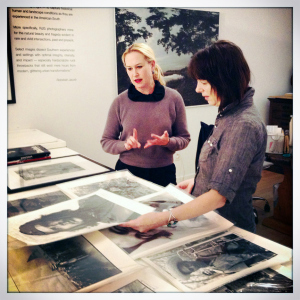 Gallerist Rebekah Jacaob, on the left, showing me the work of Cuban masters
Gallerist Rebekah Jacaob, on the left, showing me the work of Cuban mastersImagine being an art history graduate student invited into the personal studio of famed Cuban photographer “Chinolope” Lopez. One of the guys who shot the Cuban revolution for Life and Time. Not quite as famous as Alberto Korda or Raul Corrales but just as amazing. Reportedly got his nickname from Che himself. You fall in love with one of his prints. He goes to show you the negatives. But they’re a gooey mess, stuck together and irreparably damaged. You want to cry for what is lost to future generations.
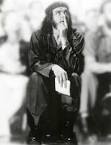 Che portrait by “Chinolope” Lopez
Che portrait by “Chinolope” LopezThat’s exactly how Rebekah Jacob remembers feeling when she was on one of her first trips to Havana. Chinolope shrugged it off but she never could. The experience represents the twin hopes and frustrations of dealing with revolutionary Cuban photography, the kind she now sells at her gallery in Charleston, South Carolina.
 Korda’s famous image, pre-cropping
Korda’s famous image, pre-croppingSixty years after they were made, these images are still gasp-inducing. There’s the infamous Korda shot of El Che before it was cropped into the ubiquitous image emblazoned on coffee mugs and T-shirts around the globe.
 Korda — courtesy of the Rebekah Jacob Gallery
Korda — courtesy of the Rebekah Jacob GalleryMy favorite though, is the epic image of victorious riders on horseback captured by the late Raul Corrales.
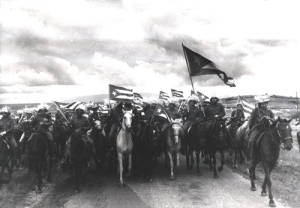 Raul Corrales
Raul CorralesCaballeria, 1960
16 x 20 in
Gelatin silver print
“Cuban photography was hot in the 90s,” Jacobs says. “In part because the revolutionary photographers were still alive and had access to American markets. Galleries like the one in Mississippi I worked for at the time would come to the island in the Spring, bringing the photographers chemicals and paper they couldn’t get on the island, and then come back in the Fall to pick up the work. ”
 A Corrales print acquired in the 90s
A Corrales print acquired in the 90sThe other part was the tireless lobbying of Sandra Levison who, in 1991, won a pioneering lawsuit against the U.S. Treasury Department that made it legal to import original Cuban art. (Read more about her in this article.)
 Korda with the photo that changed the world
Korda with the photo that changed the worldWhile the second generation of photographers who apprenticed under the masters (like Korda’s printer Jose Figueroa) were moving on, doing conceptual work and documenting the lives of ordinary Cubans, American collectors were still gobbling up vintage prints of El Che and Castro.
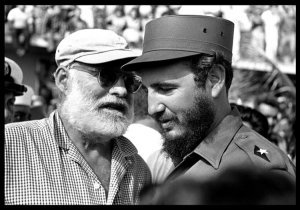 Osvaldo and Roberto Salas photography — courtesy Rebekah Jacob Gallery
Osvaldo and Roberto Salas photography — courtesy Rebekah Jacob GalleryThen Cuba stopped accepting payments in U.S. dollars and the Bush administration clamped down even harder on travel restrictions. Art collectors today could theoretically walk into darkrooms like Lopez’s and take as many prints as they like back to the United States — if only they could spend dollars or pay with credit cards in Cuba.
“Access dried up, right at the time the old masters were dying or losing their negatives to the incredible humidity,” Jacobs says. Because of Cuba’s uniquely isolated situation, they didn’t have access to photography’s digital revolution – losing out on technology that might have saved the likes of Lopez’s gooey negatives, or at least help him market those that did survive.
“Cuba just didn’t have the bandwidth and the photographers got left behind.” By 2004, Jacobs wasn’t selling nearly as much work by Cuban photographers. “The Cuban photography market stalled and the inventory just contracted.”
The good news is that change is coming. On February 27th, 2015, the second round of talks to normalize relations between Cuba and the United States gets underway in Washington and that, Jacobs says, is renewing interest in the market for Cuban revolutionary photographers. The inventory of vintage prints is still low but ever since President Obama announced the move to end détente in December, collectors have perked up. Jacobs predicts prices to skyrocket in the next six months, regardless of how long it takes for travel to return to pre-embargo levels.
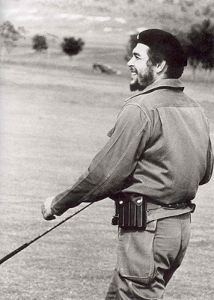 Korda photo, courtesy of Rebekah Jacob Gallery
Korda photo, courtesy of Rebekah Jacob GallerySo what makes the work of Lopez, Corrales and Korda so collectable years after its propaganda value faded? It goes beyond the images themselves, a by-product of the unique access they had to Che and Castro during the revolution. “These were great craftsmen. They improvised everything and had to print in their bathroom sinks but each one had their own unique style. The tones were all very different. You can look at a print and know who made it.”
Jacobs isn’t alone in her appreciation for and confidence in the market for Cuban photography. Here’s an excerpt from a recent piece in the Seattle Times.
That pipeline of art lovers is about to grow, predicts Alberto Magnan, whose Manhattan gallery Magnan Metz specializes in Cuban art. Magnan, who is currently in Havana, received 25 calls from collectors on Dec. 17, after Obama announced that the two countries would move to restore diplomatic ties. He is now booked through March with Cuba visits.
“It’s absolutely crazy,” he said.
Even though Americans can visit Cuba under rules dating to 2009 that allow “purposeful travel” intended to foment contact with Cubans, many shied away, Magnan said.
“It’s a hassle,” he said, referring to the need to get a license from the U.S. government and pay for works without using a U.S. credit card. Now, however, “they’re saying, ‘I want to go before everyone else does’.”


January 12, 2015
Photobombing Burma
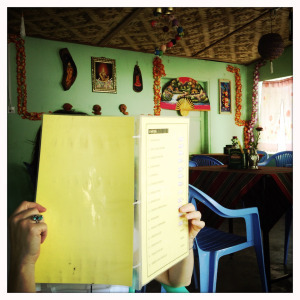 me, trying to be incognito in Myanmar
me, trying to be incognito in MyanmarIn less than 24 hours I feel like a celebrity in Myanmar. I’m drenched in sweat, my hair is haphazardly clamped up off my neck and I’m sporting none-too-sexy cargo pants yet natives keep taking my picture.
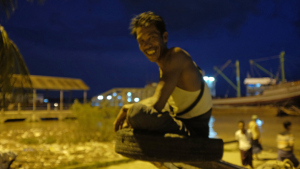 Ferry captain in Yangon — and cell phone photograper
Ferry captain in Yangon — and cell phone photograperI am walking around the docks of Yangon with my photographer husband who is happily capturing the magic hour of golden light when it first happens. Gary always asks permission of the people he approaches. So I’m not surprised when the young man squatting on the prow of a motorized dugout canoe nods a casual yes. Or that Gary instantly offers the camera’s viewfinder up so this man who ferries chickens, bananas and street food vendors across the river all day can see his own portrait.
In most third-world countries where we travel and shoot, the subjects of Gary’s digital street photos grin or giggle when they see themselves in a monitor, possibly for the first time. But this barefoot young man in a traditional longyi cocks his head, checks out his look and casually shrugs his shoulders. Then he whips a cell phone out of top fold of his longyi and snaps a picture of us.
I’m shocked. I thought Myanmar was right down there with North Korea in cell phone penetration. We’re talking about a country of 65 million people who up until a few years ago were suppressed by a military junta. I’m sure on a Burmese Facebook page somewhere there is a shot of two jet-lagged Americans, mouths gaped in astonishment.
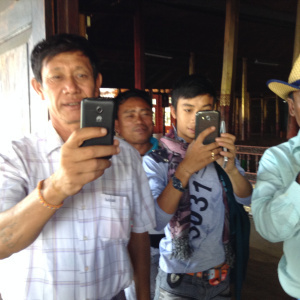 My Burmese fan club
My Burmese fan club
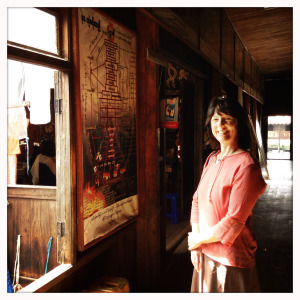 me, doing my best celebrity impersonation inside a monastery
me, doing my best celebrity impersonation inside a monastery
The next time I get the paparazzi treatment is as I step out of a boat to check out a 170-year-old monastery on Inle Lake. Again, I’m caught completely off guard. I’m surrounded by an architectural and spiritual beauty revered for centuries and yet cell phones are emerging from longyis and snapping photos of me. I feel like a specimen, a cultural curiosity suddenly on the other side of the camera.
“Is it that I look American?” I ask Gary. We do come from a country that only recently lifted travel embargoes and we’ve yet to meet another American tourist on this trip. Maybe I should enjoy the brief period of novelty before this country begins a predictable love/hate relationship with U.S. tourism.
“And that would distinguish you from German, Swiss, Canadian and Australian women how exactly?” Gary responds.
It isn’t until two policemen guarding our newly built, Chinese hotel in Mandalay take my picture that the truth occurs to me. Spoiler alert – it isn’t about me.
This is simply a country full of people who have just entered the cell phone age. Mobile giants from Norway, Qatar and Japan pounced on government contracts in 2014, getting in on the bleeding edge of connectivity.
Here’s a picture from one of those company’s Facebook site the hot August day they started selling cell phones in Mandalay. The cops taking my picture with their phones right now were probably in that line somewhere.
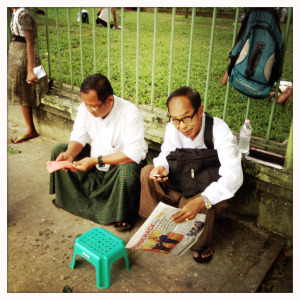 It’s not just the younger generation
It’s not just the younger generation
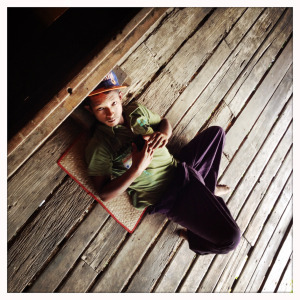 interrupting our boat driver’s screen time
interrupting our boat driver’s screen time
The number of mobile phone users in Myanmar is expected to reach up to 80 percent of the country’s population during the fiscal year 2015-16, according to Ministry of Telecommunications and Information Technology. Even if that number is wishful thinking on the part of the military government, the fact that it is wishful is illuminating. The military could have followed Kim Jung-un’s lead and kept the country disconnected, in the communications dark ages. But before I get too impressed with Burmese political altruism I read this in the Financial Times.
For the new rulers of the state still known to many as Burma, a mobile-phone network is precious because it’s a rare way to make a demonstrable change to people’s lives before the polls.
I knew it wasn’t my fashion sense. And my Americanism is not so intriguing that my every step is documented by the natives. My would-be paparazzi are just Burmese people suddenly connecting to the rest of the world. Myanmar is a ten-year-old girl with her first camera phone. She is obsessed with a new toy. Watch out world. Next will surely come the avalanche of Burmese selfies and photobombing.

January 4, 2015
Neck Rings and Bullets to the Head
 Ma Moo Ooh — http://www.garygeboyphotography.com
Ma Moo Ooh — http://www.garygeboyphotography.comI’m trying to be more moderate. Really. But I’m standing at the corner of a National Geographic moment and a slap in the face. I’ve just met Ma Moo Ooh – or at least that’s how I think she spells her name. She is thirteen years old and her job is to pose for photos with tourists visiting her Padaung aunt’s weaving shop on stilts above Inle Lake in central Myanmar.
Right now I’m distracting her but a glimpse at the smile on her aunt’s face tells me it’s okay. We are playing a game. Ma Moo Ooh writes a word in my spiral notebook and I try to copy her beautiful scroll while she collapses in giggles.
It’s part of Padaung custom for girls to begin wearing gold rings around the neck at age nine. Ma Moo Ooh loves her ten rings – it’s teen bling on another whole level and she suffers no lack of self-esteem. Until I ask her what grade she’s in. She looks down. Her parents made her stop school after three years.
“I cried and cried and cried forever,” she tells me in incredibly impressive English. “I love school and never want to quit.” But she did what was expected of her – pitching in to raise the family out of poverty by taking advantage of Myanmar’s exploding tourist industry.
I feel guilty and outraged all at once. Up until now, I confess that I’ve blamed religion for gender inequality in girls’ education around the globe. Religious extremism I should say – remember, I’m trying to practice moderation in my attitudes as well as appetite.
Up until meeting Ma Moo Ooh, I saw the issue of gender-based discrimination as epitomized by Malala Yousafzai. I’m reading her co-written memoir to give a talk about it back in Beaufort, South Carolina. The world will never forget her. She’s the Pakistani schoolgirl who won the latest Nobel Peace Prize after being shot in the face by the Taliban in 2012.
Perhaps because she has written this moving, triumphant memoir, her shooting and the reason for it (advocating for girls’ education) seemed singular to me – a horrific incident perpetrated by terrorists with religious fanaticism at their core.
I am in no way equating Ma Moo Ooh’s situation with Malala’s but what is dawning on me is that I can no longer compartmentalize the issue. It’s not just fanatics like the Pakistani Taliban or Boko Haram to blame but also a worldwide lack of commitment to girls like Ma Moo Ooh and Malala.
I’m not a mother. My outrage is not just because this is happening to little girls who could be our collected daughters. It’s is also rage for the consequences to their lives as women. Two-thirds of the world’s non-literate adults are women. Still. Today. Or at least as recently as 2012 when these results were reported to the United Nations’ Committee on Ending Discrimination against Women.
So if I’m trying to look beyond religious beliefs as the root of this inequality, why is it still happening? UNESCO experts and others who have written about the issue point out that it’s often about money. It’s the opportunity cost of a poor family losing someone to watch over younger siblings or contribute wages when their daughters go to school instead of staying at home. The neck rings that make Ma Moo Ooh feel beautiful and connected to her tribe are also economic shackles that feed her family.
I sit next to a little girl comparing our handwriting and trying not to cry for all the opportunities she will be denied. And now I understand the insistence of advocates ranging from South Africa’s Campaign for Education to the World Bank: insistence that governments have to bear the costs of educating boys and girls. Private donations and non-profits and singular efforts are not enough. Beyond building schools, governments have to make education truly free – no hidden costs for uniforms or textbooks. The United States subsidizes scores of other foreign aid projects – why not also the opportunity costs of daughters going to school instead of dropping out to become shepherds for the family’s animals or babysitters for the younger children?
It’s easy to think of this problem as too intractable to cure. But the uplifting part of all of this is that change is happening. It didn’t happen in time to save Malala from an assassination attempt. But if a girl with a bullet through her brain can still have faith then so can I. So can every other mother.
It’s not easy – one fifth of the world’s children aged 5-17 years are exploited by child labor, but even in Africa, where education disparity is proportionately among the worst in the word, the perception that it is more valuable to educate boys than girls is changing. The introduction of free primary education in Uganda, for example, caused total girls’ enrollments to rise from 63% to 83%, and enrollments of the poorest fifth of girls from 46% to 82%.
Stipend programs and conditional cash transfer programs have been employed in settings as diverse as Brazil, Yemen, Nepal, Tanzania, Malawi, Madagascar, Gambia and Kenya, and have succeeded in reducing girls’ drop-out rates and delaying early marriage.
 Schoolgirls kidnapped by Boko-Haram
Schoolgirls kidnapped by Boko-HaramBut still, I can’t help thinking of how far we have to go. Some 200 schoolgirls kidnapped in Nigeria last year are still missing and it feels like our country thinks that hashtag activism is the answer. Tweeting #BringBackOurGirls won’t save the next Malala.
Here is Malala Yousafzai’s own plea. Donate to the causes she supports: Free The Children, Save the Children & the United Nations Foundation. Or give to the charity she started: the Malala Fund.
And don’t forget the organization that has always considered education a human rights issue: Amnesty International.
If you’re passionate mostly about improving the situation in Pakistan, consider donating to the alliance formed by Oxfam, Plan Pakinstan, Care International: the Girls Education Alliance Pakistan.
But back to the Padaung women and girls in Myanmar. It’s time to get into my boat and head back to my hotel on Inle Lake. I will probably never see Ma Moo Ooh again but I will never forget her. I’m just about to close my little spiral notebook when she wants me to learn another phrase. I repeat it after her and when she is finally satisfied enough to stop giggling at my pronunciation, I write it down the way it sounds to me.
Ta-Lye-Bahn-Na. I do a double take. My phonetic spelling out of Ma Moo Ooh’s phrase looks like Taliban. She repeats the phrase. It is musical, as lovely as the expression on her face. “It means thank you, where I come from,” she tells me as she squeezes my hand goodbye.


December 30, 2014
New Year’s Resolutions & Revelations in a Traffic Circle Temple
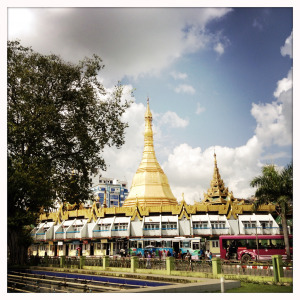 http://www.garygeboyphotography.com
http://www.garygeboyphotography.comI’ve taken off my shoes and socks at the base of a traffic circle in Yangon. As far as I know it’s the holiest of all roundabouts in the world: the Sule Pagoda. It’s not as big or famous as the giant Shwedagon, but there’s something intriguing about the way the Sule Pagoda exists literally at the center of city life here, not apart from it.
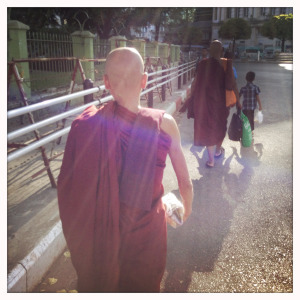 Monks walking in lanes of traffic outside Sule. http://www.garygeboyphotography.com
Monks walking in lanes of traffic outside Sule. http://www.garygeboyphotography.com
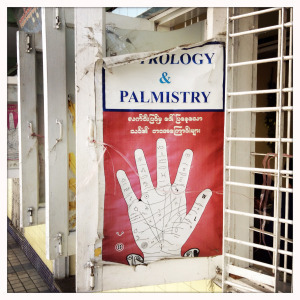 Secular shops surround the pagoda’s ground floor
Secular shops surround the pagoda’s ground floorInside you can still hear the honking horns and revving engines of Yangon’s X million residents circling the temple. But the fumes from the belching busses and bumper-to-bumper taxis gradually succumb to the scent of burning incense and strings of flowering jasmine.
Not being a practicing Buddhist, I’m not expecting any revelations. I’m mindful only of the soles of my tender feet stepping on tiles seared by Yangon’s mid-day sun. Instead, I stumble upon a New Year’s resolution. It practically jumps out at me, by virtue of being the only text written in English. It’s on a list I figure is a rough translation of the Noble Eightfold Path. My stomach rumbles, on que, as I read about eating in moderation.
Every year around this time I make lists that inevitably include a certain number of pounds to lose or food to eliminate from my diet. Maybe it’s the melodic chanting of the women on prayer mats all around me but it occurs to me that my resolution obsession could use moderation.
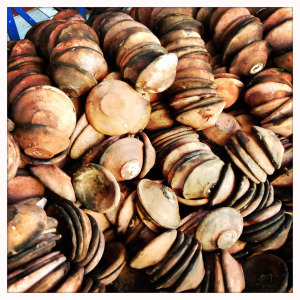 recycled candle holders http://www.garygeboyphotography.com
recycled candle holders http://www.garygeboyphotography.comThis little hand-painted list with questionable grammar is actually a sign that I’ve been approaching New Year’s resolutions selfishly. Instead of resolving to cut back on calories to make myself look better next year, I could consider food as a resource the whole world needs to share. Calories are a gift of life-sustaining energy and like all gifts, not to be hoarded by one person. It’ll be tough, shifting this focus from self-absorption to self-realization. I’m not the meditative type and I’ll need all the help I can get.
Luckily the Sule Pagoda has that covered. I hand over some crumpled khat banknotes in exchange for a packet of gold leaf and stand in line for what looks like a miniature ski lift in the shape of a swan. But when it’s my turn, the lady in charge of sending the little swan gondola up a cable to the gilded pagoda grabs my hand. She wants me to crank the handle myself. I’m already sweaty and feeling conspicuously pale and clumsy in this land of slender women half my size but there’s no time like the present to start shedding those calories. In moderation of course.


December 23, 2014
Leave Lonely Planet at home and bring fiction when you travel to Myanmar
As soon as I click the “submit” button and buy my plane ticket, my mind is already obsessing on the details of the travels ahead. I download the latest Kindle version of Lonely Planet like a drug addict counting the number of pills in a bottle. I know I shouldn’t – real travel experiences come from spontaneous decisions made in the moment. But the left-brain side of me wants to memorize the details, cross potential pitfalls off a million lists and plan the perfect trip.
None of which is really possible when it comes to Myanmar. U.S. sanctions were only lifted a few years ago and it’s changing so fast that guidebooks specifics are practically useless. And the beautiful photographs are like landmines to avoid – if they’re in the book then the reality has already been altered.
Luckily I’ve found a cure for my own inevitable over-planning. I fill my carry-on bags with tattered paperbacks because fiction is the only truthful account of life in a place I’ve never been.
For Myanmar, that means stepping back to the time when it was known as Burma. I start with an old favorite: Daniel Mason’s “The Piano Tuner.” Never mind the movie version, the first sentence is what made me yearn to visit Myanmar in the first place.
“In the fleeting seconds of final memory, the image that will become Burma is the sun and a woman’s parasol.”
The book is a slow burn, tracing one man’s seduction. Not by the woman he meets but by the entire country. In the end the English piano tuner can’t trust anything he thought he knew. He doesn’t care, as long as he never has to leave. It’s lush and romantic and every time I read it I am as shamelessly besotted with the idea of Burma as Edgar was.
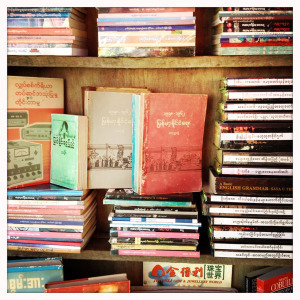
Outdoor Yangon bookstore http://www.garygeboyphotography.com
Which is why, the first day we walk through the sticky heat of Yangon I head straight for the book section. The book section isn’t in a bookstore. It lines entire city streets – a reminder that this country is new to Internet and that books were once the intellectual lifeline to the outside world.
I pick up a cheaply printed knock-off copy of George Orwell’s Burmese Days – knowing that it will snap me out of The Piano Tuner’s spell. Orwell’s account of the same era in Burmese history is the brutal hangover after my earlier indulgence. He describes a country not meant to be over-lorded and capable of doling out exacting punishment to any visitor. Particularly those of a Colonial bent. I have English blood and this book makes it back up and run through my veins in the opposite direction. I grew up in a different, one-time British colony – South Africa – and the vulnerable yet ultimately cruel Elizabeth feels far from fictional.
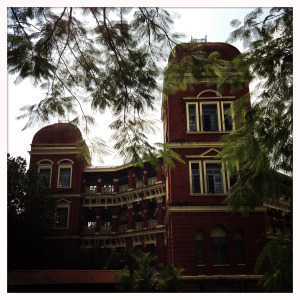
Reminders of British Days in Burma
So whose story should I trust as I set out on my own journey through Myanmar, the romantic Edgar in “The Piano Tuner” or the disillusioned Flory in “Burmese Days”? The first winds up shot in the back and the latter blows his own brains out – neither one comforting to a traveler in a country only recently emerging from the chokehold of a military junta. I suspect the truth of Myanmar will split the two extremes, like the wavering air.
“The woman walks into a mirage, into the ghost reflection of light and water that the Burmese call than hlat. Around her, the air wavers, splitting her body, separating, spinning. And then she too disappears. Now only the sun and the parasol remain.”

December 18, 2014
Travelers and Sanctions: Should We Wink And Go Anyway Or Wait Them Out? Clues in Cuba and Myanmar
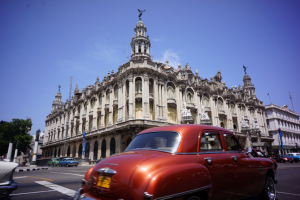
Havana — photo by Gary Geboy
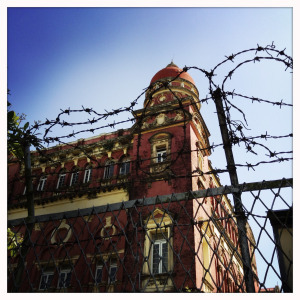
Yangon — photo by Gary Geboy
This is a true story of travel, sanctions and two optimistic Millennials: Amuh is from Mandalay, Myanmar and Alex from Havana, Cuba. One has come of age after Americans began traveling to his country, the other has never known a world without sanctions.
Amuh drives a taxi owned by his mother and chatters freely about politics. Right now he’s pissed that elections in Myanmar have been delayed until late 2015 but thinks Aung Sang Suu Kyi’s party will win a majority and change the constitutional amendments that prevent her taking her rightful role as president. He worked legally in Malaysia and realizes that his philosophy diploma from a Burmese degree mill university system is useless. He plans on starting a business before starting a family.
Alex is also a college graduate. His degree is in English and he spends all day trying to convince tourists that his uncle owns the Buena Vista Social Club and he can get them a good ticket. He feels sorry for Americans because we don’t get free healthcare and education, thinks Raul Castro is awesome for allowing cell phones in Cuba but can’t afford the $6 an hour it would take in an internet café to build the tour guide website he hopes will provide a better future for his wife and baby girl.
Amush and Alex’s stories explain why travel is so important to a free society and why even the most principled tourists have doubts about the effectiveness of sanctions.
As someone who grew up in South Africa during the era of Apartheid, I have complicated feelings and experiences with international sanctions. I applaud the humanitarian ideals behind them. But I’ve seen, first-hand, the economic misery they create when immoral, corrupt governments use sanctions to dig their own hole deeper.
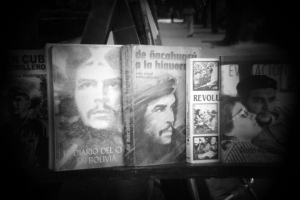
photo by Gary Geboy
I’ve also seen how inflated Americans perceive our importance to be. And how hypocritical we can be. Myself included. We Americans somehow think that visiting Cuba under the special exemptions of guided photo clubs or university tour groups is okay, but that skirting the rules and arriving on our own via Mexico or Canada is somehow immoral. We’re okay with pilfering baseball players from their $100-a-month island teams but buying Cuban cigars is evil. On a good day we can see across the Florida straights but people are forced to risk their lives to reunite with their families. The original intent of the sanctions might have made sense 54 years ago but the way we dance around modern-day Cuba is nothing short of ethical contortionism.
I’d like to think that the heavy, well-intentioned hand of American sanctions will help, like they eventually did in South Africa. But Alex is still hanging out in Plaza Vieja, gratefully counting his egg and sugar rations and waiting for Raul’s next handout. I don’t know whether to be comforted by his naïve optimism or heartbroken.
But what about Amuh’s more cautious hopes for a better future? Again, I’d like to give credit to sanctions. But for the last twenty years, European and Chinese tourists largely ignored them and visited in well-heeled droves. The surface changes evident in Myanmar today may have had as much to do with Internet access, Chinese and Indian economic investment and the diplomacy and well wishes of ordinary tourists.
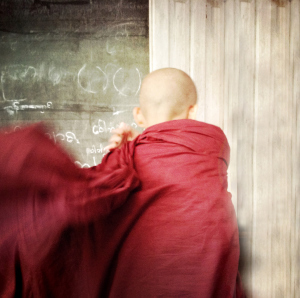
photo by Gary Geboy
I’ve dreamed of visiting Myanmar ever since working/traveling in three of its bordering countries: Thailand, Laos and China. I stood on the banks of the Mekong, my tattered, beloved copy of “The Piano Tuner” in hand, wondering if I could look myself in the mirror if I crossed that river to the land once known as Burma. The beloved daughter of its national hero was under house arrest, the military junta was killing monks and jailing journalists.
I couldn’t do it. I waited until the sanctions were lifted and “The Lady” was free. I waited until my old agency, Ogilvy PR Worldwide opened an office in Yangon. I waited for my conscience to be clear. And guess what? I still have mixed feelings. I’ll be writing about my travels in posts to come but I have no answers. I could buy an Aung Sang Suu Kyi T-shirt, made in China of course, and not have to look over my shoulder or worry that the shopkeeper would be arrested. But I was still not allowed to venture out West, where Rohingya Muslims are still kept in what are essentially concentration camps.
If anything, I feel like I waited too long. Not because Myanmar is already so tourist-savvy and overpriced. But because by staying at home I could not be a witness – to its triumphs or its tragedies.


